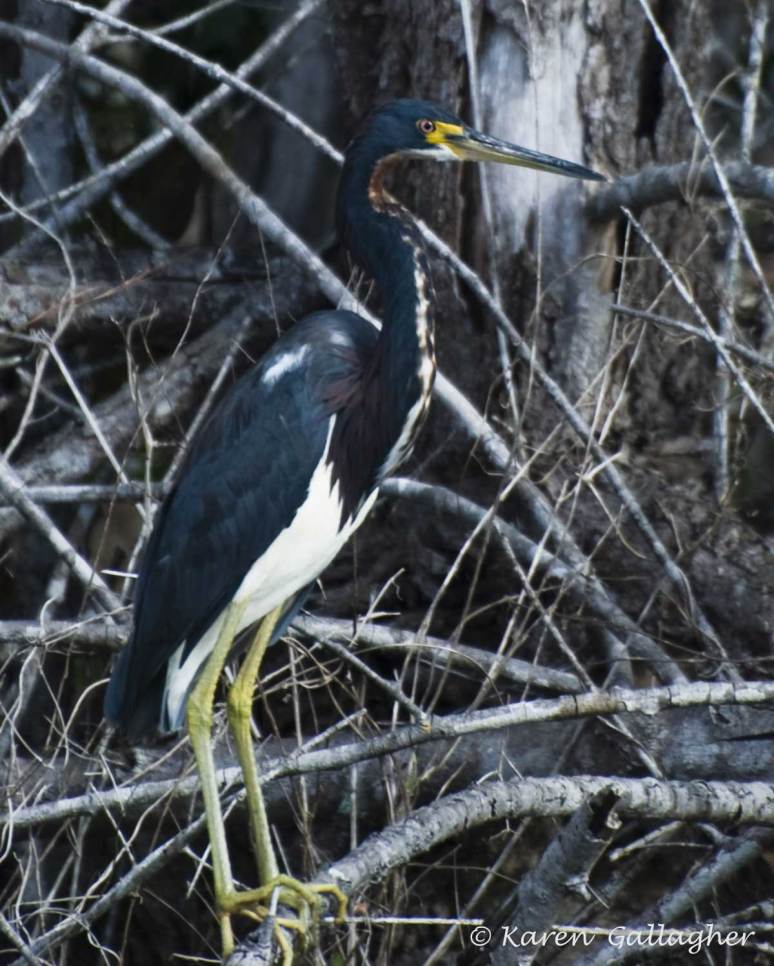One Tricked Out Bird!
Our recent quest for local birding sites led us to an area of the Everglades that we had never visited before. There a desolate road skirted the eastern edge of the Glades where waving golden sawgrass dotted with verdant green tree islands stretched as far as our eyes could see. Along one side of the road flowed a drainage canal plied by huge alligators. Low bushes and small trees hugged the sides of the canal where wading birds congregated. One bird that immediately caught our attention was the flashy tricolored heron. Their pristine white belly and white lined necks and backs gaily decorated with slate blue and magenta tinged chestnut feathers, this medium sized heron sports greenish yellow legs and a bright yellow black tipped bill during the non-breeding season. But in the spring, when Papa Tricolor courts the desire of his heart, both sexes don long blue and white filamentous plumes on their head and neck and rust painted plumes on their backs for the courting. If that’s not enough, their bills turn to blue and their legs to pink. Whoa! Can Saks do that for you? These photos, however, were taken in November, not March so you’ll have to wait awhile for the fancy duds.
We found this adult heron perched on a treetop. When we lingered a bit too long, it rose on powerful wings and leveled out in smooth flight.
There were lots of places to roost including canal-side brush.
For tricolored herons nesting and parenting is a shared responsibility. The male picks out the homestead in the reeds or on a tree branch for his bride. When it’s time build a nest, both honeymooners contribute to the stick woven structure. Once the eggs are laid, the couple takes turns keeping them toasty warm. After the chicks arrive, both parents care for and feed them until they grow feathers and are old enough to leave the nest. Young tricolored herons have reddish-brown feathers on their heads and necks.
You can find tricolored herons in North America along eastern and southern coasts. In winter months, they migrate to warmer climes in the States as well as the Caribbean and South America as far south as the Amazon. Protective of their fishing territory they fight off all predators. When fishing, they run back and forth with their bodies low and flattened and their beaks ready to seize fish and other aquatic prey.
I took this image of a related heron species, the green heron, from a nearby lakeshore. The wood is part of an old dock washed up by a hurricane. I spent sometime watching this young heron investigate two slider turtles sunning on the dock’s edge. Right after I took this photo the lead turtle quickly pulled his head inside his shell. Smart turtle—just look at that beak!










Pingback: Bird Ecology Study Group » I and the Bird #89
Hi Karen, Incredible photos of the Tricolored Heron and great information too. I guess I will have to take a trip to Baja California to see one of these gorgeous birds unless I am able to spring for an all out birding trip to Florida or the Caribbean.
Super capture of the heron and the turtles. That must have been a very interesting encounter. What a great birding day for you.
Beautiful photos. Enjoyed your observations and the info about plumage.
The only Tri-colored Heron that I have seen was a juvenile. The difference in plumage is striking! Thanks for sharing your experience!
Pingback: Romantic Blue « Morningjoy’s Weblog